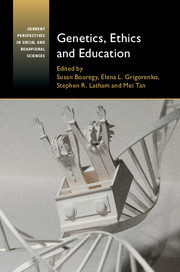Book contents
- Genetics, Ethics, and Education
- Current Perspectives in Social and Behavioral Sciences
- Genetics, Ethics, and Education
- Copyright page
- Contents
- Figures
- Tables
- Contributors
- Abbreviations
- Introduction
- 1 What Is Heritability and Why Does It Matter?
- 2 Molecular Genetics and Genomics
- 3 Can (and Should) We Personalize Education Along Genetic Lines? Lessons from Behavioral Genetics
- 4 Early Adversity and Epigenetics: Implications for Early Care and Educational Policy
- 5 Intelligence: The Ongoing Quest for Its Etiology
- 6 A Behavioral Genetic Perspective on Non-Cognitive Factors and Academic Achievement
- 7 Precision Education Initiative: The Possibility of Personalized Education
- 8 Using Genetic Etiology to Intervene with Students with Intellectual Disabilities
- 9 Ethical Implications of Behavioral Genetics on Education
- 10 Genomic Literacy and the Communication of Genetic and Genomic Information
- 11 Legal Issues Associated with the Introduction of Genetic Testing to the Education System
- 12 Ethical Risks and Remedies in Social-Behavioral Research Involving Genetic Testing
- 13 Development of the Personal Genomics Industry
- 14 Ethical Issues in Using Genomics to Influence Educational Practice
- 15 Teaching and Genetic/Genomic Variation: An Educator’s Perspective
- 16 Will the Next Einstein Get Left in the Petri Dish? Be Careful What You Wish for in the Designer Baby Era
- Conclusion: How Might School Systems Use Genetic Data?
- Index
- References
Introduction
Published online by Cambridge University Press: 06 October 2017
- Genetics, Ethics, and Education
- Current Perspectives in Social and Behavioral Sciences
- Genetics, Ethics, and Education
- Copyright page
- Contents
- Figures
- Tables
- Contributors
- Abbreviations
- Introduction
- 1 What Is Heritability and Why Does It Matter?
- 2 Molecular Genetics and Genomics
- 3 Can (and Should) We Personalize Education Along Genetic Lines? Lessons from Behavioral Genetics
- 4 Early Adversity and Epigenetics: Implications for Early Care and Educational Policy
- 5 Intelligence: The Ongoing Quest for Its Etiology
- 6 A Behavioral Genetic Perspective on Non-Cognitive Factors and Academic Achievement
- 7 Precision Education Initiative: The Possibility of Personalized Education
- 8 Using Genetic Etiology to Intervene with Students with Intellectual Disabilities
- 9 Ethical Implications of Behavioral Genetics on Education
- 10 Genomic Literacy and the Communication of Genetic and Genomic Information
- 11 Legal Issues Associated with the Introduction of Genetic Testing to the Education System
- 12 Ethical Risks and Remedies in Social-Behavioral Research Involving Genetic Testing
- 13 Development of the Personal Genomics Industry
- 14 Ethical Issues in Using Genomics to Influence Educational Practice
- 15 Teaching and Genetic/Genomic Variation: An Educator’s Perspective
- 16 Will the Next Einstein Get Left in the Petri Dish? Be Careful What You Wish for in the Designer Baby Era
- Conclusion: How Might School Systems Use Genetic Data?
- Index
- References
- Type
- Chapter
- Information
- Genetics, Ethics and Education , pp. 1 - 14Publisher: Cambridge University PressPrint publication year: 2017



